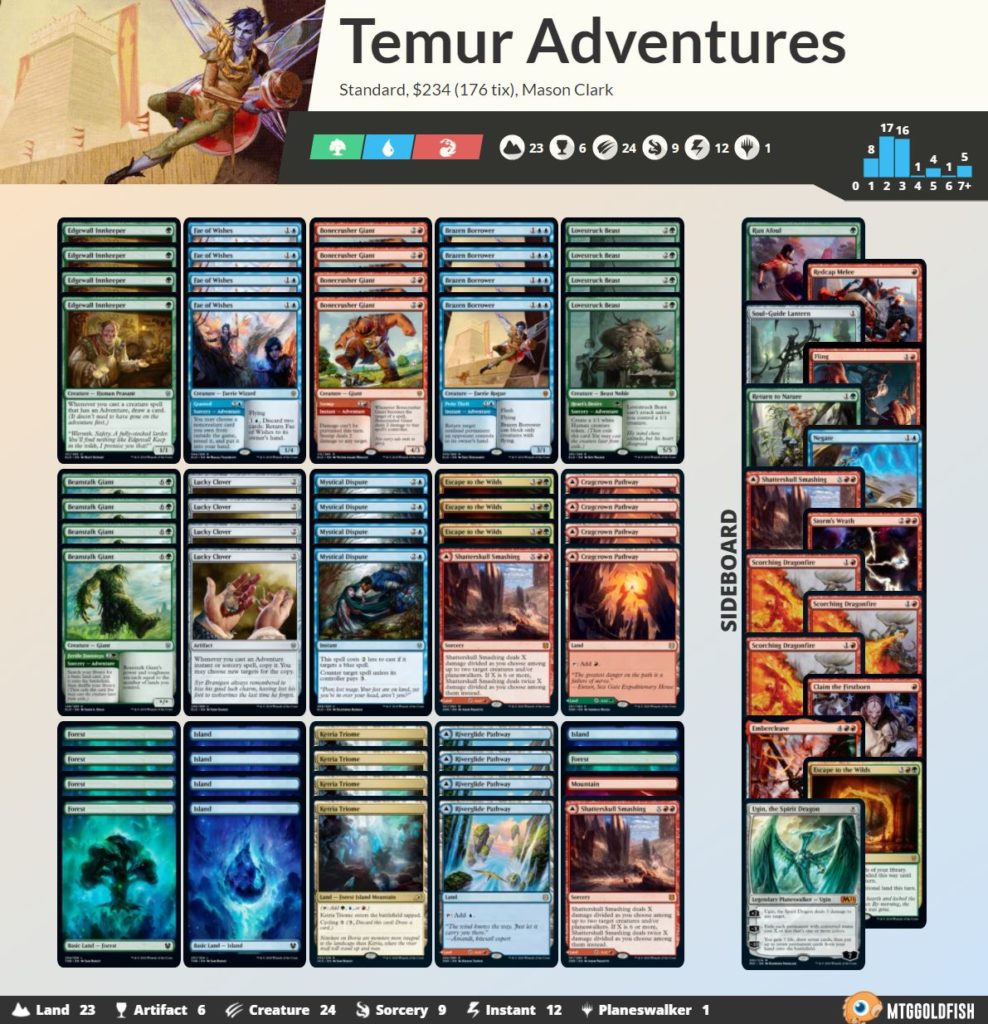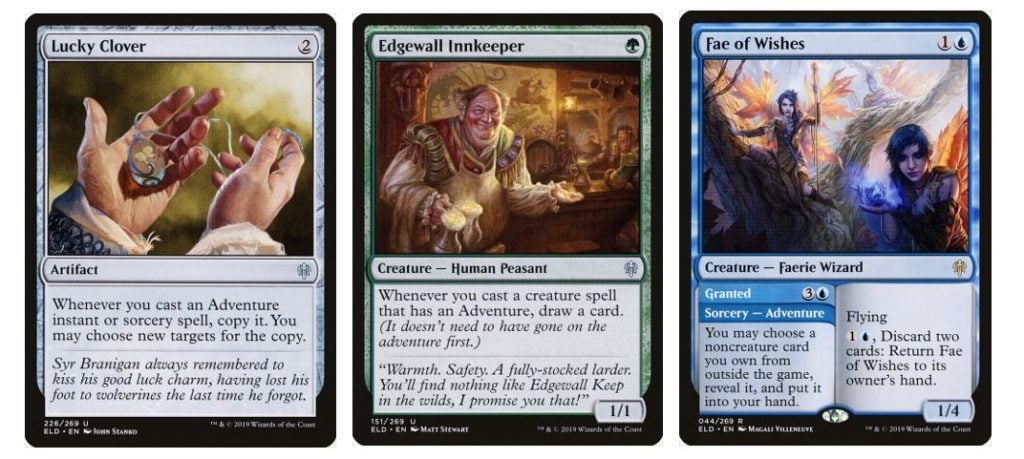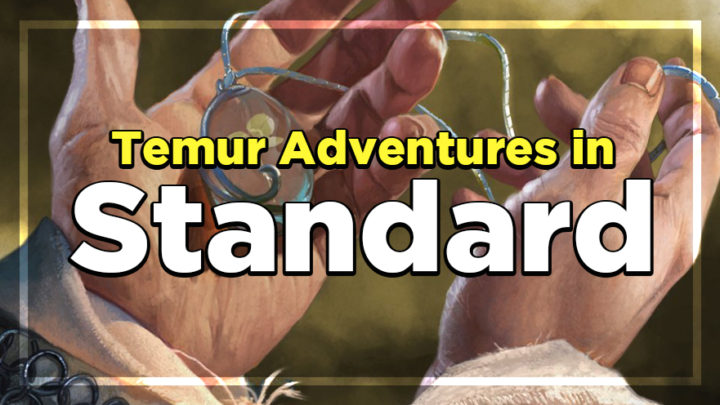In my article on Standard last week, I mentioned that Omnath Adventures is probably the best deck in the format given Uro’s banning. Lo and behold, it has since become a dominant force in Standard. Like many players, I jumped right onto the Arena ladder after the announcement with my Four-Color Adventures deck, ready to battle. But as the days went on, I found myself frustrated with the deck’s mana base.
Four-color Adventures is a strong deck, but it can have clunky mana at times — and that’s a big negative to me, especially in Standard. Even if your deck is just functional, you will get a lot of wins that other decks miss out on. This is a big draw to proactive mono-colored decks; we’ve seen Mono-Green take advantage of this (plus some very large creatures) for the last six months or so.
All this led me to start looking at Temur Adventures — and I’m happy to report that clean mana and an excellent game plan have led to a lot of success.

Buy this deck from Card Kingdom
Export this deck to MTG Arena via MTGGoldfish
The Main Deck
If you haven’t played Adventures before, don’t worry — your main game plan is very straightforward: use cards like Edgewall Innkeeper and Lucky Clover to generate insurmountable card advantage. You mainly accomplish this by playing a lot of adventure creatures, including cards like Brazen Borrower and Bonecrusher Giant that double as interaction. You can also use cards like Beanstalk Giant and Escape to the Wilds to create a large mana advantage. Once you have all the mana you need, you can use both the spell part and creature part of your adventure cards every turn to ensure you’re playing more spells that affect the board than your opponent. If all else fails, you play four copies of Fae of Wishes, which allow you to grab some powerful game-ending spells or niche answers from the sideboard.

Functionally, Temur Adventures hasn’t changed much since Throne of Eldraine entered Standard. Typically, the deck has about four main deck flex spots and a sideboard that you can modify as needed. This creates an interesting tension when playing against the deck — if you’ve been playing Magic for the last year, you know what Adventures is up to; nothing they do will surprise you besides what they “wish” for with Fae of Wishes. Basically, both players are playing heads up on what the Adventure player’s plan is, and it’s on the Adventure player’s opponent to maneuver through it.
The great thing about playing Adventures is that you have so many options — from getting every ounce of value out of your cards to simply curving out on the opponent and putting them on the back foot. This can lead to “overwhelming” turns, where you’re presented with fifteen possible lines of play before you even get to combat or consider casting Granted. One of my goals today is to help with this by presenting some heuristics and providing insight into plays and play patterns.

Before we get into that, though, a quick word on the build of the deck above. The main deck for this Temur Adventures deck is very stock, with the one outlier being four main-deck copies of Mystical Dispute. Dispute has proven to be a fine card against most non-blue decks, and against blue decks, it’s an amazing trump card. I have opted for the full four main as a way to combat all the rogue decks (which can be challenging) and to have a huge tempo play against various Omnath builds.
But the most exciting part of this build of Adventures is the sideboard. This deck is constructed so that you can bring cards in and out and catch your opponent off guard without giving up too much in the “wish” board.
The Sideboard
Now that you have a general understanding of what Adventures is trying to accomplish, let’s go over every sideboard card: why you have them, and when it’s a good time to grab them.
Ugin, the Spirit Dragon

This is your “reset the game” button. If your opponent ever gets too far ahead, this card will put you back at square one. One tip to remember is that Beanstalk Giant has a CMC of seven; you’ll want to try to get one on the board before you cast Ugin, since it will most likely live through the minus and attack for at least eight damage.
Embercleave

This is a sideboard card that I haven’t seen anyone else adopt yet, but I think it’s a huge pickup for your wish board. Embercleave is a great way to win the game and break through board stalls. You’ll want to wish for this card when you need to push through lethal damage; for example, you can grab it against control decks to make every creature you play for the rest of the game a must-answer threat. It also synergizes very well with Beanstalk Giant.
Fling

Just like ’Cleave, it’s a great way to end the game.
Run Afoul

Having a “wish” board means you can grab this to answer threats in game one and then sideboard it in for games two and three. It’s mainly good against Rogues, but if that deck ticks down in popularity, try a different card in this slot.
Soul-Guide Lantern

Kroxa and Dance of the Manse have been on the uptick in the last few days, and both are incredibly difficult to beat without this card.
Negate

When I have a Clover, I’ll often wish for a win con the turn before I plan on casting it. In these situations, I’ll use my second wish to grab Negate to stop opponents from trying to thwart my plans with counterspells, discard, or removal. Negate is also just a fine card to grab vs. spell-heavy decks.
Return to Nature

This is the “They Have What?” slot. This card is not incredible in any given situation, but it answers a lot of weird things that come up. I find myself grabbing it as another Kroxa answer after having used one Soul-Guide Lantern, or to kill Embercleave or Anax.
Shatterskull Smashing

Some players really like having a Fabled Passage in the sideboard to grab in games where mana is tight. While I also like having access to a land, I’m hesitant to have it eat up a whole slot, so I turned to this powerful double-faced card. When needed, it’s a red source (the color we have the fewest sources of), and in the late game, it normally kills two creatures.
Storm’s Wrath

Adventures needs a way to clear the board against aggro decks, and waiting until you have eight mana for Ugin often doesn’t cut it. Storm’s Wrath will answer most board states and usually leave a Lovestruck Beast behind to block for the following turns. Don’t forget — it also deals four damage to planeswalkers!
Escape to the Wilds

Sometimes, you don’t need a specific answer — you just need to find more things to do. For that reason, there’s a fourth copy of Escape in the sideboard to wish for. It’s great in situations when it’s not clear which card is best, but you also want to cast Granted for the sake of mana efficiency.
Claim the Firstborn

I’ve been going back and forth between Claim the Firstborn and Shadowspear in this slot, but I eventually opted for Claim as a cheap way to swing damage races. This is a card that I often use in combination with a Fling or Embercleave. It’s a cheap grab when you can wish for two or more cards because of Clover and you have some spare mana lying around. If aggro keeps growing in popularity, consider swapping this for Shadowspear as a way to regain life after you’ve stabilized.
Redcap Melee

If you need a cheap answer against Mono-Red, grab this. The main thing to remember is that you can only hit non-red creatures if you sacrifice a land, which can be detrimental when you’re facing Mono-Green and Rogues.
Scorching Dragonfire

This is for aggressive decks, and it’s a card I plan to sideboard in in a lot of match-ups. Mystical Dispute is a powerful game one card and is rarely dead, but against aggressive decks, cheap answers for creatures are much better. That way, you can develop your board freely in the early game and won’t get stuck with dead counterspells later on.
Sideboarding & Match-Up Guide
In the next bit, I’m going to share a quick sideboard guide and what I call a “match-up guide”: some quick insight into what matters in the match-up and your goals going into the games. As always, a sideboard guide should be evaluated game to game and won’t be right 100% of the time, so I hope this holistic approach will lead to lots of success.
Four-Color Adventures

No changes.
Your plan is to get on the board quickly and disrupt their plays with Disputes and keep them on the back foot. Their deck is stronger on a card-to-card basis, but ours is leaner and more efficient.
Rogues

In: 3 Scorching Dragonfire, 1 Run Afoul
Out: 4 Lovestruck Beast
This match-up can be challenging the first couple times you play it; they have a lot of flyers and permission to keep you from doing your thing. I prioritize answering Nighthawk Scavenger above all else; the card can quickly end the game and buys them a lot of time. Whenever possible, answer a rogue if they are tapped out, but not if it will leave you with no answers to Nighthawk Scavenger.
Mono-Red

In: 3 Scorching Dragonfire, 1 Redcap Melee, 1 Storm’s Wrath
Out: 4 Mystical Dispute, 1 Beanstalk Giant
The opponent’s plan is to quickly get on the board, then win with Embercleave or Torbran. Your goal is to establish board presence and make their attacks challenging. This is a match-up where you want to play the creature side of Fae of Wishes ASAP to slow down the pressure.
Mono-Green

In: 1 Scorching Dragonfire, 1 Storm’s Wrath
Out: 2 Mystical Dispute
Like Mono-Red, Mono-Green wants to establish a board quickly, but their creatures outgrow Scorching Dragonfire. A lot of their more powerful cards cost three or four mana and they often go all-in on Primal Might, so I actually don’t mind having a couple Mystical Disputes here. Your Disputes will be pivotal in stopping those turns and giving you time to work toward an Ugin, which will usually end the game. Be wary of Stonecoil Serpent in this match-up, as you are typically going to have a hard time answering it.
Rakdos Kroxa

In: 1 Return to Nature
Out: 1 Mystical Dispute
This match-up is a real grind fest, and they can lean on Kroxa to run you out of cards. I swap one Dispute for one Return as a way to answer an early Kroxa or Tymaret Calls the Dead. They operate on a low land count and try to use all their mana every turn, so the main deck Disputes are still good in the post-board games.
Omnath Ramp

No changes.
A lot of the same principles for playing against Four-Color Adventures hold true here, though they don’t get on board as quickly. Plan to build your board presence, then disrupt them with Mystical Disputes and Brazen Borrowers.
Grixis Control

No changes.
This match-up is kind of a free win. They’ll try to run you out of cards, but that’s hard when most of your cards are worth two or more. Even effects like Stomp and Petty Theft are not necessarily worth a whole card will still add up over the course of the game. I like to take a value-heavy approach to this match-up — I won’t play an Innkeeper until I can guarantee at least one card out of it. Their mana is clunky, so look to force awkward plays in the early game and use Mystical Dispute to ruin their plans.
Tips & Tricks

Lightning round on things to remember:
- Fling and Embercleave are how you will normally win the game
- Don’t be afraid to play Fae of Wishes as a 1/4 against aggressive decks
- Be cautious about exposing Edgewall Innkeeper and Lucky Clover to your opponent’s removal in games two and three before you get any value out of them
- Mystical Dispute can still be good in non-blue match-ups
- When in doubt, believe in the ’Cleave!
Ready for Adventure?

Temur Adventures rewards you for playing a lot of Standard — even if you haven’t been playing this deck yourself! Succeeding with this deck often comes down to knowing what your role is in the early game. Are you going to need to forgo the value of Lovestruck Beast’s 1/1 token to get a 5/5 on the board? Do you need to hold up Petty Theft to answer their powerful turn four play instead of just playing a Bonecrusher Giant that’s on an adventure? Should you use Fae of Wishes to grab Claim the Firstborn or Redcap Melee? These are all things that get easier as your format knowledge grows.
Try not to get too frustrated when you first pick up the deck; small mistakes are inevitable. Once you get the rhythm of this deck, you will be rewarded with lots of interesting games and wins! What more can you ask for?
Loving this deck? Have an interesting card for the sideboard? Tweet @Masoneclark and @Card_Kingdom to let us know what you’re up to!

Mason Clark is a grinder in every corner of the game who has played at the pro level and on the SCG Tour with Team Nova. Whether he’s competing in Standard, Historic or Modern, Mason plays with one goal in mind: to be a better player than he was the day before. Check out his podcast, Constructed Criticism, and catch his streams on Twitch.

